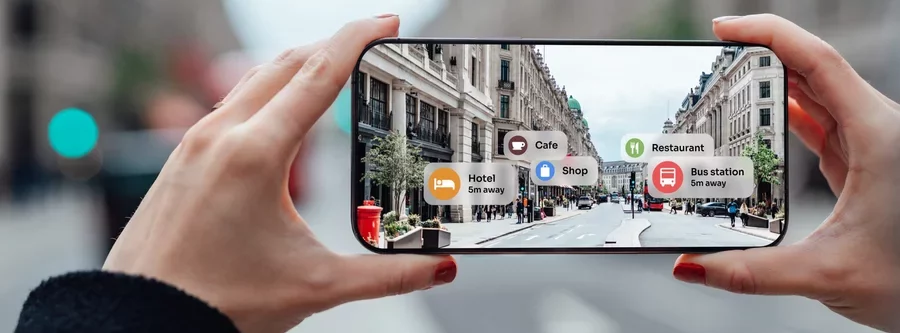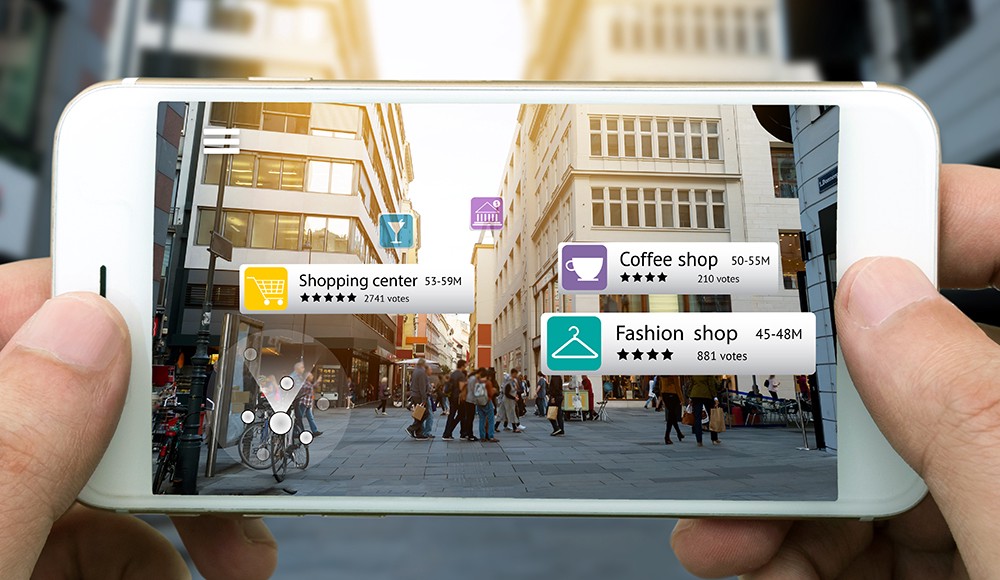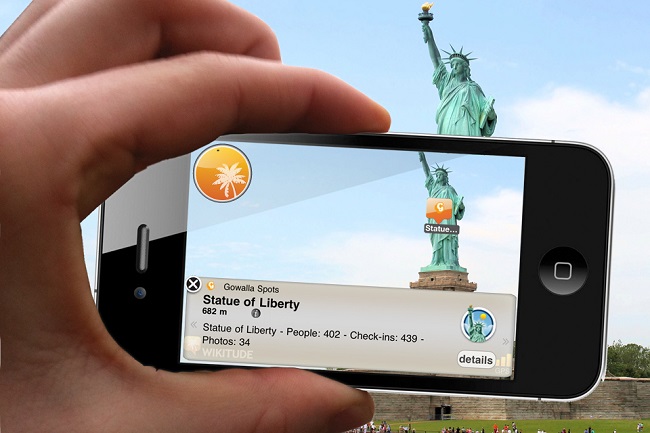Everything you need to know to build a location-based AR app

So, you’re in a foreign country, walking away from the crowded touristy streets in search of an authentic cultural experience. You feel the hot sun on your skin and a whiff of the tasty traditional cuisine. Not sure where it comes from? Just launch an AR app on your phone, point it at the street and you’ll see the names, ratings, and specialties of every restaurant on the horizon. Sounds too good to be true, doesn’t it? But location-based augmented reality apps like this are already here, ready to make the lives of their users so much easier and more entertaining.

True, the AR industry faces certain technical and social challenges. Creating location-based AR apps falls into the first category. Placing AR objects like signs or pictures over physical objects on the go without any markers is a job that not every AR app development company can do.
But let’s have a look at some location-based AR development concerns and ways to tackle them.
The challenges of GPS-based AR apps
Developers need to put a lot of effort into delivering a good location-based AR mobile app. The device and the app have to define the location of the physical object (e.g. building), calculate distance and attach a virtual object (sign, text, picture). Simply slapping on the digital element won’t do the trick. It has to be placed accurately, stick tightly, remain stable, and not jiggle when the user is moving or changing angles.
But high levels of accuracy are hardly achievable with only iPhone or Android location services. The issue requires a complex solution. Developing a high-quality GPS-based AR app requires using specialized augmented reality SDKs with the SLAM method and markerless technology.
Marker-based vs markerless apps
Augmented reality mobile apps fall into two categories: marker-based or markerless (location-based AR apps).
Marker-based apps are all about image recognition. Basically, these AR applications are programmed to identify specific preset markers (QR code, picture, symbol, pattern) through the smartphone camera. The moment this app recognizes the marker, an augmented reality object pops up to deliver the necessary information.
Markerless or location-based apps, however, don’t need any patterns or markers to function.
They deliver an engaging AR experience based on the camera, GPS, accelerometers, and other sensors to define the location of the user on the go and all surrounding objects. These location-based apps are exactly what the AR industry needs to engage more people in augmented reality.
You can build markerless AR apps to use in an indoor or outdoor location. Unlike GPS-based apps, AR apps for indoor navigation will use beacons to recognize the location of a mobile device. The key downsides of this type of app development are high dependence on infrastructure and the cost of installation and maintenance.
The SLAM technology
Simultaneous localization and mapping (SLAM) made a breakthrough in 2017. This revolutionary technology allows apps to understand the environment and create maps for more accurate digital object placement. Thanks to SLAM’s algorithms and sensors, the virtual objects in AR apps that overlay the real-world stay still, and don’t bounce or float when the user is moving. Perfect!
Major augmented reality SDKs
Here are four of the most popular AR SDKs that support SLAM and markerless technology.
ARKit
Just like with native mobile app development, iOS, and Android have different AR SDKs. The official AR SDK from Apple, ARKit, was introduced in iOS 11. When this OS update went live, owners of iPhone and iPad devices with the CPU A9 and higher could instantly try running AR apps. This includes:
iPhone 6s Plus or later
iPad 2017 or later
iPod touch 7th generation
ARKit offers everything you need to build a great location-based AR app: Visual Inertial Odometry (VIO) for accurate environment tracking, 1080p HD imagery support, scene understanding and lighting estimation, powerful devices with advanced camera sensors and a big, supportive community.
ARCore
Unlike Apple, Google has been fiddling with AR for some time now. The effort they put into creating Google Glass and Tango transformed into the experience Google used to launch its own AR SDK – ARCore.
Don’t be mistaken: Tango and ARCore are different projects. The main difference is that ARCore doesn’t require additional or specific hardware to bring augmented reality to Android users – it’s all in their phones.
One of ARCore’s strongest features is mapping. It’s great for collecting and storing real-world 3D localization data – a handy trick for markerless AR apps. The SDK also has some great positioning and environment features like anchoring objects (to place digital objects accurately), environmental understanding (detects horizontal surfaces) and motion tracking (determines the device’s position and orientation in regard to its movement).
Android device fragmentation has always been a double-edged sword for users. That’s why ARCore’s biggest inconvenience is the small number of devices that can actually use it. Google promises to increase this number to roughly 100 million devices, but for now, ARCore is only available on Android devices running at least 7.0 Nougat and higher. Some devices will need at least Android 8.0 to run ARCore.
Wikitude
Wikitude has become a household name in AR application development. Having the world’s leading cross-platform AR SDK, Wikitude can boast over 20 000 developed applications and more than 100 000 registered AR developers.
This all-in-one AR framework provides an SDK for Android, iOS and smartglasses to create both marker-based and markerless AR apps. It features image recognition and tracking, object recognition and tracking, 3D markerless tracking (SLAM) and geolocation. Thanks to extensions, Wikitude is also compatible with other platforms and frameworks. It offers plugins for Cordova and Unity, a Titanium module and a Xamarin component.
But the best part about Wikitude is that it has recently settled the ARKit vs ARCore debate. And the winner is… Wikitude! In SDK 7.2, Wikitude premiered its “Seamless AR Tracking” feature – SMART.
SMART blends ARCore, ARKit and Wikitude’s SLAM engine into a single AR SDK. This remarkable API makes augmented reality apps cross-platform and suitable for a much wider array of devices. According to Wikitude, SMART will allow covering 92,6% of iOS devices and about 35% of Android devices with high-quality markerless AR apps. And thanks to this new feature, Cordova, Titanium and Xamarin developers will finally be able to work with ARKit and ARCore.
No more platform-specific code! The Wikitude SDK will analyze the user’s type of device and determine which one should be used in that particular case: ARKit, ARCore or Wikitude’s SLAM. The downside? Wikitude is pretty pricey. If you want to build a markerless GPS-based AR app, the commercial license will cost you around 1990 EUR per year for one Android and one iOS app. On the other hand, if you use Wikitude to create a stellar AR product, you’ll return the investment in no time.
KudanSLAM
As the name suggests, KudanSLAM knows a thing or two about simultaneous localization and mapping. It offers a unique approach to tracking and mapping and has modules designed to work with already-generated SLAM maps. Object positioning in Kudan’s AR apps is highly precise and accurate, with no drifting or trembling – perfect for markerless GPS-based augmented reality apps.
KudanSLAM is very flexible. It allows the creation of AR apps for different hardware and operating systems, targeted at a wide variety of purposes and audiences: mobile, IoT, AI, robotics, you name it. Kudan is also extremely configurable, easy to implement, and shows impressive performance results. The trick about Kudan’s AR app speed is in low-latency tracking at high frame rates. This means that, unlike ARKit and ARCore, KudanSLAM apps can run on low-performance processors.
Kudan’s pricing varies but there is a free non-commercial license for indie developers, making it a good fit for budding startups.
The opportunities of location-based augmented reality
According to a Deloitte report, 88% of medium-sized businesses are already using or testing AR for some purposes. Markets and Markets predicts that the AR market will grow from $22.5 billion in 2021 to $88.4 billion by 2026. Just imagine that a couple of years ago this multi-billion-dollar market was a geeky hype nobody took seriously. Now, industries like retail, education, manufacturing, construction, healthcare, tourism, and marketing make use of augmented reality. All thanks to the advent of powerful devices and slick SDKs for smooth location-based AR development.
Retail
Geo-based AR apps are a great way to shake up customers. The experience they offer is not only exciting; it’s also extremely relevant, allowing businesses to make precise offers and provide additional information to the right people at the right moment.
For example, Lowe’s Home Improvement built the AR app to help customers find any product faster inside their stores. The application detects the user’s current location using computer vision algorithms and then guides to a preferred item. The product price, customer reviews and more info are updated in real-time.
Real estate
Imagine that you’ve found a house in a cozy district, and wondering about its price, interior, etc. Location-based AR is the fastest & easiest way to find it out even without calling your agent. In fact, that’s what InmobiliAR does: the application lets you find properties for sale around, view the interior through the AR feature and request an appointment in a few clicks. This saves loads of time in buying/renting process, offering a brand-new kind of experience for clients.
What is more, augmented reality enables showing houses that are still under construction and customizing its colors, furniture, etc. With digital 3D objects pinned to real-world locations, clients could view their future homes to the smallest details. This would result in faster & easier closing of deals. Sounds great, doesn’t it?
Tourism & hospitality
Location-based augmented reality is a great way to navigate travelers through a large hotel or airport and help to learn more about popular sightseeing spots nearby. Customers expect an interactive experience from companies with AR directional arrows, distances, and info imposed on real-life objects. So don’t hesitate to let them discover the nearest restaurants, shops or hotels. Why not turn their trip into a personalized tour guide?

Healthcare
In healthcare, doctors already use AR apps to find the nearest defibrillators and the best route to them. This way, augmented reality improves the quality of healthcare service and even helps to save lives. Although, most of its use cases are yet to be discovered.
Construction
Geo-based AR allows visualizing entire buildings or their component models by showing their exact locations with 3D models placed on a construction site. This simplifies project management and decision-making, preventing future problems. The Gamma AR app is a great example of how markerless augmented reality can help avoid costly errors. By overlaying 3D BIM models on the actual construction sites, it reveals any planning issues so you can make the necessary adjustments before the project is finished.
Games
With geo AR features and location-based AR games, businesses can enhance their customers’ experience. For example, in a Mossland game players can buy & customize landmarks nearby, populate them with magical creatures and even sell them for real money.
Or how about “Zombies, run!” that turns your daily jogging routine into a real adventure? Running from zombies, players complete different missions and collect supplies.
These are just a few examples to demonstrate the growing demand for location-based AR apps across industries. Of course, you can find your own way to apply augmented reality in your domain.
Conclusion
For sure, building high-quality markerless GPS-based AR apps is not a piece of cake. For an application to be truly entertaining, it has to be accurate and natural. The combination of SLAM, markerless technology and a specialized AR development SDK can make the app perfectly precise.
Just remember to find a reliable AR app development company from Ukraine or one of the UK’s top AR app development companies so you can build an excellent application together.
Augmented reality gains popularity worldwide, so don’t hesitate. The opportunity for your location-based AR app might be just around the corner.
FAQ
What is location-based augmented reality?
Location-based augmented reality apps can project virtual objects into a real-world environment. Markerless or location-based AR requires no physical markers to work, in comparison to marker-based augmented reality which ties the virtual object to a marker like a QR code, image, etc.
How does AR affect various industries?
Augmented reality technologies enhance the customer experience for any industry. Salespeople can use AR to launch impressive marketing campaigns and promote products or services. AR can be also used for educational purposes to help students better understand the material and engage with the subject.
How does location-based AR work?
Location-based AR apps use a phone’s camera, accelerometer, compass, and other sensors and technologies to identify the smartphone’s position and place the virtual object in the needed spot in the real-world environment.
How is AR technology being used in apps?
AR can overlay a digital object over the real-world environment. AR accesses the device’s camera and shows both real-world objects visible via the camera and virtual objects added to the app by developers.
How to build a location-based augmented reality app?
Steps to build a location-based AR app:
Decide on the app idea and what should be added as virtual content; the simplest option is just adding some text over real-world objects.
Choose tools: they depend on the devices you would like your app to run (Android, iOS, or both).
Integrate the augmented reality geolocation data using iPhone or Android location services for better performance.
What AR technologies are there?
Augmented reality uses SLAM technology (simultaneous location and mapping), depth detection, and image projection.
How to make money with a location-based AR app?
You can make paid entertainment apps or AR-enabled mobile games. Alternatively, use a location-based AR app as an additional marketing tool for your business to increase brand awareness. Make an app where customers can have a closer interaction with your product: try on clothes or equipment, see how the product works, place virtual furniture items in their homes, and more.




